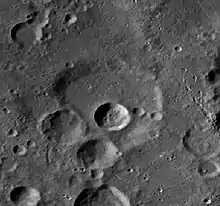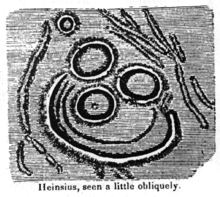Heinsius (crater)
Heinsius is an eroded lunar impact crater that lies in the southwestern part of the Moon. It is named after German astronomer Gottfried Heinsius.[1] It is located to the northwest of the prominent crater Tycho, and rays from that formation pass to the north and south of Heinsius as well as marking the rim and interior with material. To the south-southwest of Heinsius is the larger walled plain Wilhelm.
 LRO image | |
| Coordinates | 39.5°S 17.7°W |
|---|---|
| Diameter | 64 km |
| Depth | 2.7 km |
| Colongitude | 19° at sunrise |
| Eponym | Gottfried Heinsius |

The southern part of this crater has been heavily damaged by subsequent impacts. Both Heinsius B and Heinsius C lie across the southern and southwestern rim, while Heinsius A is located in the southern interior floor. Together these three satellite craters form a triangular arrangement with the rims only separated by a few kilometers from each other. If Heinsius possessed a central peak, it is now covered by the outer rampart of Heinsius A.
The northern half of the rim is in better shape, although still worn and rounded due to impact erosion. There is a wide shelf along the northeastern inner wall. A small craterlet lies exactly on the northwestern rim. The northern interior floor is relatively level and featureless.
Satellite craters

By convention these features are identified on lunar maps by placing the letter on the side of the crater midpoint that is closest to Heinsius.
| Heinsius | Latitude | Longitude | Diameter |
|---|---|---|---|
| A | 39.7° S | 17.6° W | 20 km |
| B | 40.0° S | 18.6° W | 23 km |
| C | 40.6° S | 17.9° W | 23 km |
| D | 38.8° S | 20.7° W | 7 km |
| E | 37.8° S | 19.5° W | 17 km |
| F | 40.5° S | 19.7° W | 7 km |
| G | 38.3° S | 14.5° W | 11 km |
| H | 37.4° S | 18.5° W | 8 km |
| J | 39.3° S | 20.4° W | 8 km |
| K | 38.5° S | 18.5° W | 5 km |
| L | 41.2° S | 18.4° W | 8 km |
| M | 40.9° S | 15.3° W | 14 km |
| N | 37.3° S | 14.7° W | 7 km |
| O | 38.8° S | 14.8° W | 5 km |
| P | 39.4° S | 13.8° W | 40 km |
| Q | 39.9° S | 14.5° W | 35 km |
| R | 40.2° S | 20.7° W | 5 km |
| S | 39.6° S | 16.9° W | 7 km |
| T | 39.7° S | 16.5° W | 7 km |
References
- "Gazetteer of Planetary Nomenclature | Heinsius". usgs.gov. International Astronomical Union. Retrieved September 8, 2017.
- Andersson, L. E.; Whitaker, E. A. (1982). NASA Catalogue of Lunar Nomenclature. NASA RP-1097.
- Bussey, B.; Spudis, P. (2004). The Clementine Atlas of the Moon. New York: Cambridge University Press. ISBN 978-0-521-81528-4.
- Cocks, Elijah E.; Cocks, Josiah C. (1995). Who's Who on the Moon: A Biographical Dictionary of Lunar Nomenclature. Tudor Publishers. ISBN 978-0-936389-27-1.
- McDowell, Jonathan (July 15, 2007). "Lunar Nomenclature". Jonathan's Space Report. Retrieved 2007-10-24.
- Menzel, D. H.; Minnaert, M.; Levin, B.; Dollfus, A.; Bell, B. (1971). "Report on Lunar Nomenclature by the Working Group of Commission 17 of the IAU". Space Science Reviews. 12 (2): 136–186. Bibcode:1971SSRv...12..136M. doi:10.1007/BF00171763. S2CID 122125855.
- Moore, Patrick (2001). On the Moon. Sterling Publishing Co. ISBN 978-0-304-35469-6.
- Price, Fred W. (1988). The Moon Observer's Handbook. Cambridge University Press. ISBN 978-0-521-33500-3.
- Rükl, Antonín (1990). Atlas of the Moon. Kalmbach Books. ISBN 978-0-913135-17-4.
- Webb, Rev. T. W. (1962). Celestial Objects for Common Telescopes (6th revised ed.). Dover. ISBN 978-0-486-20917-3.
- Whitaker, Ewen A. (1999). Mapping and Naming the Moon. Cambridge University Press. ISBN 978-0-521-62248-6.
- Wlasuk, Peter T. (2000). Observing the Moon. Springer. ISBN 978-1-85233-193-1.